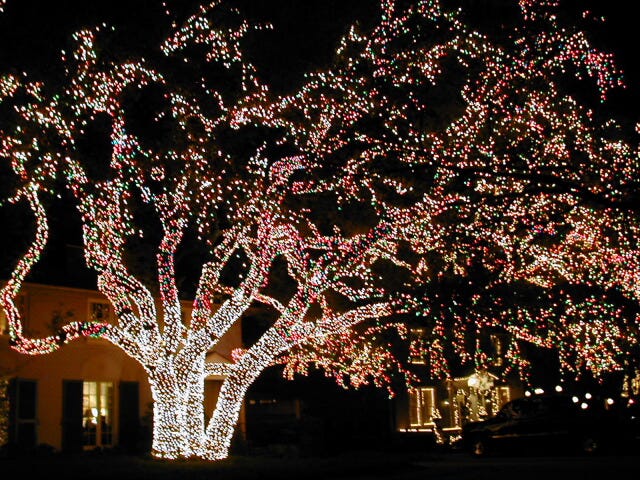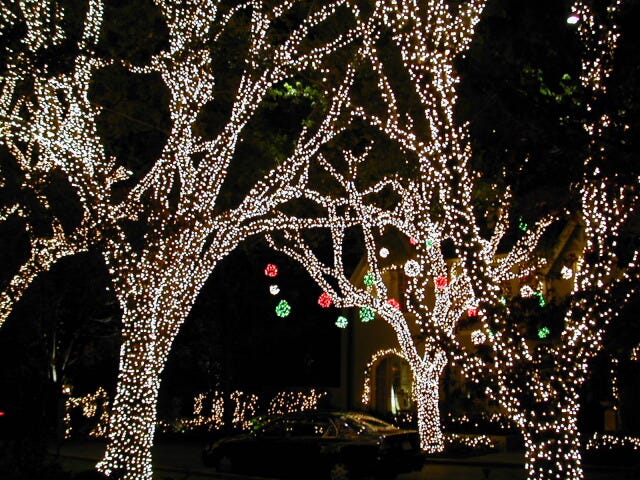From the Archives: A Light Unto the Wealth of Nations
A dive into the economics of Christmas displays.


This article is 20 years old—a bit of the information appeared in The Substance of Style—but it’s always been a favorite. While reporting it, I was particularly taken by the idea that landscaping businesses use installing Christmas lights as a way to generate business during the off season. Prices have increased (inflation!) but the general point still holds.
As Christmas lights go up on homes around the country, you've probably noticed that the displays seem to get more elaborate every year. No longer does decorating a single evergreen in the front yard suffice. Every tree demands its own ropes of light, wrapping trunks as well as branches. Ubiquitous icicle lights drape even the most generic tract home in sparkling abundance.
Arbiters of taste may clash over the merits of white versus colored bulbs, and energy Puritans may denounce the inessential use of electricity. But even stylistic snobs can't entirely deny the appeal of a thousand points of holiday light.
Today's lavish displays do more than brighten the night. They tell a story of economic progress. Like the electronic gadgets aimed at gift buyers, the tiny lights outlining rooflines and tree limbs illustrate new sources of growth, productivity, and prosperity. Aesthetic pleasure, they tell us, is an increasingly important source of economic value and hence of new jobs and business opportunities. And the same trends that boost living standards in other areas also make Christmas lights more abundant.
A holiday-lighting dollar simply goes further than it used to. Homeowners buying Christmas lights benefit from the same intense retail and manufacturing competition that have driven down prices and improved reliability in so many other industries, raising the American standard of living.
As a teenager in the mid-1980s, David VanderMolen's job was to buy and install holiday lights for his family's Charlotte, Michigan home. Each year his parents would give him $10, enough for two 35-light strings, each 20 feet long, from Kmart. If the weather wasn't too bad, a string of lights would last about three years. VanderMolen eventually built up a collection of 350 miniature lights, enough to make his house the most elaborately decorated in the neighborhood.
Today, that display would be nothing special. You can buy a 100-light string, nearly 50 feet long, for $2.44 at Wal-Mart. Even without adjusting for inflation, VanderMolen's old $10 annual budget would cover more lights in a single year than he could accumulate over seven years in the 1980s. Today's cheaper lights, mostly made in China, also last longer.
"The stuff now is so well made that you can put it up in November before it gets too cold or wet, and leave it up until a January thaw, and it doesn't all fall apart," says VanderMolen.
As a result, today's homeowners can put on light shows that would have made theme park news a generation ago. Says VanderMolen, "It is easy and inexpensive to put up a tasteful display, and not much more cost or effort to try and humiliate your weak-willed neighbors."
Not everyone wants to climb around on the roof, however, and not everyone has the skills to put together an attractive display. More and more homeowners are contracting out the lighting work, creating satisfying jobs that never existed before. It's part of the long-term trend toward greater and greater specialization. The business also illustrates just how experience improves productivity even in service industries.
Christmas Decor, based in Lubbock, Texas, has more than 350 franchise locations throughout the U.S. and Canada. The company estimates that its franchisees do more than $32 million in holiday light business a year. (At least four other national companies offer similar franchises.) Most franchisees are landscaping companies looking for ways to keep working through the slow winter months. Like the inventory controls that have improved efficiency in manufacturing, adding a holiday lighting service allows landscapers to avoid the boom and bust of hiring and laying off employees.
Franchisers like Christmas Decor give local contractors the benefits of scale-not only buying lights by the container load but learning from experience. Christmas Decor franchisees serve about 300,000 customers each year. "The information you receive from that kind of volume is scientific," says Brandon Stephens, the company's director of marketing. "If there's a problem, it's going to repeat."
If one local contractor figures out a way to save labor, the company incorporates the technique nationwide, changing its vendor specifications if necessary. To make wrapping tree branches more efficient, for instance, Christmas Decor has suppliers deliver lights in balls rather than lined up on cards, the way homeowners shopping at Wal-Mart find them.
Hiring a lighting contractor saves homeowners trouble and raises quality expectations, creating a ratchet effect that in turn generates more demand for specialists.
People who do the same job over and over again get better and better at it. They hang lights in more consistently attractive patterns. The more people see professional displays, the more they expect to be wowed. Although lighting contractors do some direct marketing, their most effective advertising is the impressively decorated house down the block. Exposure creates demand.
"The more lights that go up, the more lights that go up," says Tom Tolkacz, president of Swingle Tree Co., a Christmas Decor franchisee in Denver. His business has about 70 employees during the holiday season, 20 to 30 more than before Swingle added the lighting franchise. (At its seasonal peak, the landscaping company employs about 200 people.) Its lighting business continued to grow right through the recession, posting some of its greatest gains ever in 2001 and 2002.
Most customers are two-income couples with homes valued at $400,000 or more, says Tolkacz, a "middle market" of people who would not have hired professionals in the past. Some less-affluent single parents also hire the company because they "don't want to get on the roof." The service appeals more to baby boomers than to the over-60 crowd, who tend to believe that hiring someone to install holiday lights is frivolous.
That disparaging attitude toward aesthetics affects us not only as consumers deciding where to spend our money but as citizens trying to understand the sources of future economic growth. We mourn the loss of manufacturing jobs—"real jobs"—and ignore growing aesthetic professions, from installing holiday lights and landscaping lawns to giving manicures and facials, from designing brochures to crafting granite countertops.
Yet in an advanced economy, in which competition is pushing the prices of goods ever lower and their quality ever higher, enhancing the look and feel of people, places, and things will become more and more important over time. Just as surely as the horsepower of a car engine or the warmth of a blanket, the pleasure of twinkling Christmas lights offers real value.
Last-Minute Shopping? Buy one of my books!
(For those who dislike Amazon, you can also order from an independent bookseller via Bookshop.org or from Barnes & Noble.)
The Fabric of Civilization: For the textile lover, of course, but for anyone interested in history, technology, or why our world is the way it is. More than one reader has told me it reminds them of James Burke’s Connections series, and it should appeal to fans of Matt Ridley (who gave it a nice endorsement blurb) and Steven Johnson.
The Power of Glamour: It’s a beautiful artifact, so you can buy it for non-readers who want something for the coffee table. The images serve as a visual soundtrack to a work of intellectual theory, including two chapters limning the history of glamour in its pre-modern and modern forms. This book decodes glamour as a form of communication and visual persuasion. Better for René Girard or Martin Gurri fans than for the typical fashionista.
The Substance of Style: An oldie but a goodie. What’s the value of making things look good? Status isn’t the only reason people care about how things look and feel. The trend that inspired the book is a background phenomenon now, but the analysis still holds—all the more so as we enter an era of AI images on demand. More accessible than The Power of Glamour, this is the book for anyone interested in design, branding, or why they buy cool-looking things they don’t need. Features a famous paragraph on toilet brush holders.
The Future and Its Enemies: The classic is enjoying a resurgence of interest, some of which I discussed in this early Substack post. It puts both the rise of illiberalism and the burgeoning “progress studies” movement in a useful framework—the conflict between ideals of bottom-up dynamism and top-imposed stasis—that crosses traditional political and cultural lines. (Just substitute “Donald Trump” where it says “Pat Buchanan,” keeping in mind that Buchanan was a more serious thinker.) For your loved ones who like arguing on the internet or listening to political podcasts.
Thanks for your support!




This was beautiful! I love Christmas lights and one of my favorite things every year is going to different neighborhoods to see all the displays. You reminded me of a similar dynamic with fireworks: families or groups of families are putting on fireworks displays today that whole towns put on when I was a kid.